The Inclusion of Acidic and Stormwater Flows in Concrete Sewer Corrosion Mitigation Studies
Abstract
1. Introduction
2. Materials and Methods
2.1. Concrete Samples Preparation
2.2. Microscopical Investigation on Gypsum Formation and Removal by Water Flow
2.3. SEM-EDS for Sulfur Content on the Surface during Sulfate Attack
2.4. Flowing Acidic Solution Experiments
2.5. Unconfined Compressive Strength and Elastic Modulus
3. Results
3.1. Gypsum Formation on Concrete and Its Removal by Liquid Flows
3.2. Sulfur Content on the Concrete Surface during Sulfate Attack
3.3. Effect of Flow and Concentration
3.4. Mechanical Strength
4. Discussion
5. Conclusions
Author Contributions
Funding
Institutional Review Board Statement
Informed Consent Statement
Data Availability Statement
Conflicts of Interest
References
- Wiener, M.S.; Salasab, B.; Quintero-Núñez, M.; Zlatev, R. Effect of H2S on corrosion in polluted waters: A review. Corros. Eng. Sci. Technol. 2006, 41, 221–227. [Google Scholar] [CrossRef]
- Zhang, L.; De Schryver, P.; De Gusseme, B.; De Muynck, W.; Boon, N.; Verstraete, W. Chemical and biological technologies for hydrogen sulfide emission control in sewer systems: A review. Water Res. 2008, 42, 1–12. [Google Scholar] [CrossRef] [PubMed]
- Fytianos, G.; Baltikas, V.; Loukovitis, D.; Banti, D.C.; Sfikas, A.; Papastergiadis, E.; Samaras, P. Biocorrosion of Concrete Sewers in Greece: Current Practices and Challenges. Sustainability 2020, 12, 2638. [Google Scholar] [CrossRef]
- Crownmag. Innovative Coating Materials for Corrosion Protection of Sewer Network Pipes. Available online: http://crownmag.gr/en/ (accessed on 14 August 2020).
- Merachtsaki, D.; Tsardaka, E.-C.; Tsampali, E.; Simeonidis, K.; Anastasiou, E.; Yiannoulakis, H.; Zouboulis, A. Study of Corrosion Protection of Concrete in Sewage Systems with Magnesium Hydroxide Coatings. Environ. Sci. Proc. 2020, 2, 27. [Google Scholar] [CrossRef]
- Merachtsaki, D.; Fytianos, G.; Papastergiadis, E.; Samaras, P.; Yiannoulakis, H.; Zouboulis, A. Properties and Performance of Novel Mg(OH)2-Based Coatings for Corrosion Mitigation in Concrete Sewer Pipes. Materials 2020, 13, 5291. [Google Scholar] [CrossRef] [PubMed]
- Breysse, D. 3-Deterioration processes in reinforced concrete: An overview. In Woodhead Publishing Series in Civil and Structural Engineering; Maierhofer, C., Reinhardt, H.-W., Dobmann, G., Eds.; Woodhead Publishing: Sawston, UK, 2010; Volume 1, pp. 28–56. [Google Scholar]
- Attiogbe, E.K.; Rizkalla, S.H. Response of concrete to sulfuric acid attack. ACI Mater. J. 1988, 85, 481–488. [Google Scholar]
- Kawai, K. Deterioration of Concrete Exposed to Flowing Sulfuric Acid Solution. In Proceedings of the 13th International Conference on Civil and Environmental Engineering (ICCEE-2014), Busan, Korea, 23–24 September 2014; p. 10. [Google Scholar]
- Ookame, Y.; Hatano, Y.; Kawai, K. Study on Long Term Concrete Deterioration Due to Sulfuric Acid. In Proceedings of the Third International Conference on Sustainable Construction Materials and Technologies, Kyoto, Japan, 18–21 August 2013. [Google Scholar]
- Mori, T.; Nonaka, T.; Tazaki, K.; Koga, M.; Hikosaka, Y.; Noda, S. Interactions of nutrients, moisture and pH on microbial corrosion of concrete sewer pipes. Water Res. 1992, 26, 29–37. [Google Scholar] [CrossRef]
- Nielsen, A.H.; Hvitved-Jacobsen, T.; Jensen, H.S.; Vollertsen, J. Experimental Evaluation of the Stoichiometry of Sulfide-Related Concrete Sewer Corrosion. J. Environ. Eng. 2014, 140, 04013009. [Google Scholar] [CrossRef]
- Monteny, J.; De Belie, N.; Vincke, E.; Verstraete, W.; Taerwe, L. Chemical and microbiological tests to simulate sulfuric acid corrosion of polymer-modified concrete. Cem. Concr. Res. 2001, 31, 1359–1365. [Google Scholar] [CrossRef]
- Monteny, J.; Vincke, E.; Beeldens, A.; De Belie, N.; Taerwe, L.; Van Gemert, D.; Verstraete, W. Chemical, microbiological, and in situ test methods for biogenic sulfuric acid corrosion of concrete. Cem. Concr. Res. 2000, 30, 623–634. [Google Scholar] [CrossRef]
- Aviam, O.; Bar-Nes, G.; Zeiri, Y.; Sivan, A. Accelerated Biodegradation of Cement by Sulfur-Oxidizing Bacteria as a Bioassay for Evaluating Immobilization of Low-Level Radioactive Waste. Appl. Environ. Microbiol. 2004, 70, 6031–6036. [Google Scholar] [CrossRef] [PubMed]
- Hadja, K.; Kharchi, F. The Erosion of Reinforced Concrete Walls by the Flow of Rainwater. Int. J. Concr. Struct. Mater. 2017, 11, 151–159. [Google Scholar] [CrossRef]
- Roghanian, N.; Banthia, N. Development of a sustainable coating and repair material to prevent bio-corrosion in concrete sewer and waste-water pipes. Cem. Concr. Compos. 2019, 100, 99–107. [Google Scholar] [CrossRef]
- Portland Cement Association. PCA, Types and Causes of Concrete Deterioration; PCA: Skokie, IL, USA, 2002; p. 16. [Google Scholar]
- Design Criteria and Standard Drawings. Available online: https://www.vaughan.ca/services/DesignCriteria/files/Sanitary%20Sewerage%20System.pdf (accessed on 14 August 2020).
- ASTM. C469/C469M—10 Standard Test Method for Static Modulus of Elasticity and Poisson’s Ratio of Concrete in Compression; ASTM Internatiomal: West Conshohocken, PA, USA, 2012. [Google Scholar]
- Kawai, K.; Ogawa, Y.; Tsubone, K.; Yamaguchi, Y. Degradation of concrete immersed in sulfuric acid for a long term. Cem. Sci. Concr. Technol. 2017, 70, 397–404. (In Japanease) [Google Scholar] [CrossRef]
- ASTM D7234-19. Standard Test Method for Pull-Off Adhesion Strength of Coatings on Concrete Using Portable Pull-off Adhesion Testers; ASTM Internatiomal: West Conshohocken, PA, USA, 2019; Available online: https://www.astm.org/Standards/D7234.htm (accessed on 14 December 2020).
- Kamiński, M. The Stochastic Perturbation Method for Computational Mechanics; Wiley: Hoboken, NJ, USA, 2013. [Google Scholar]

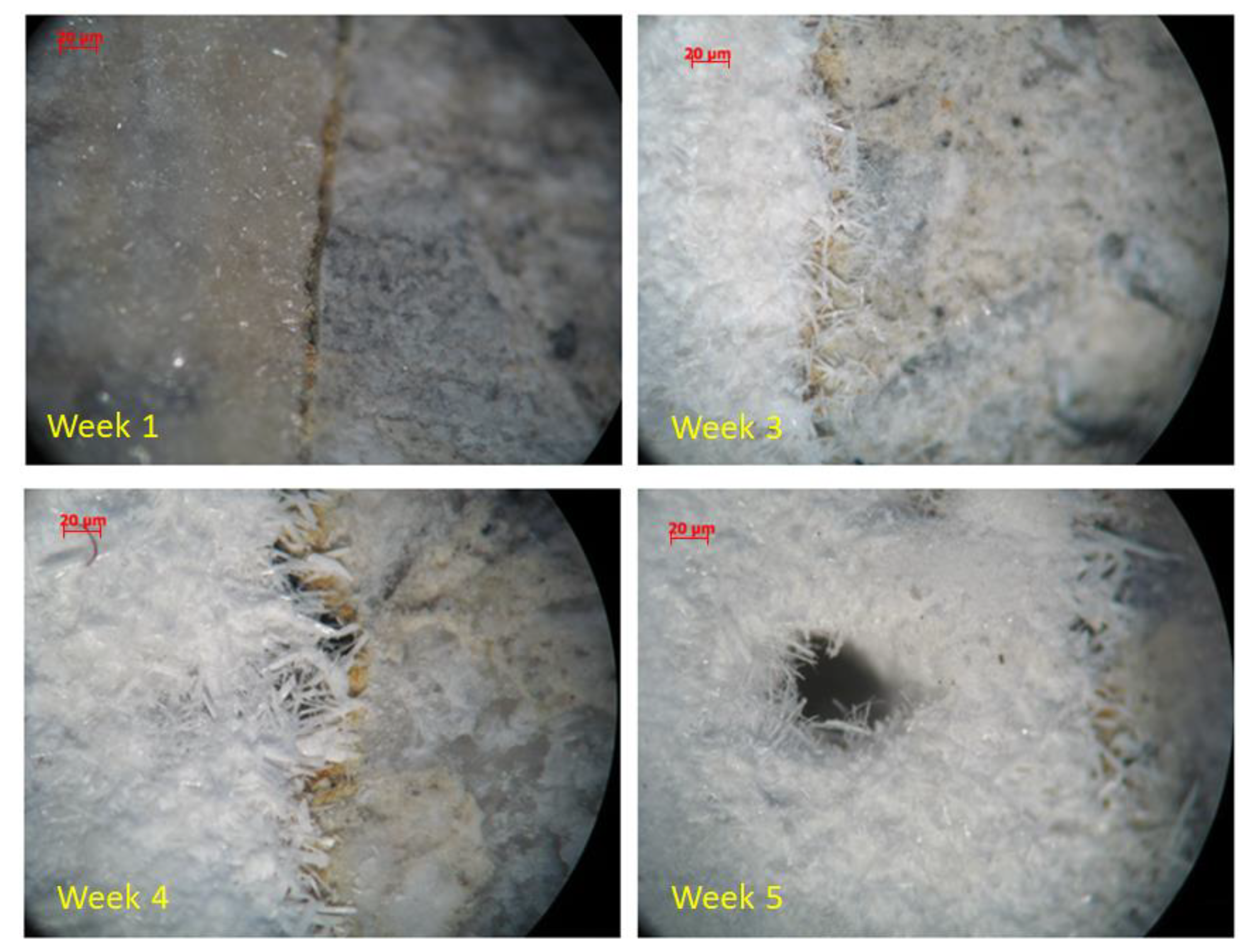
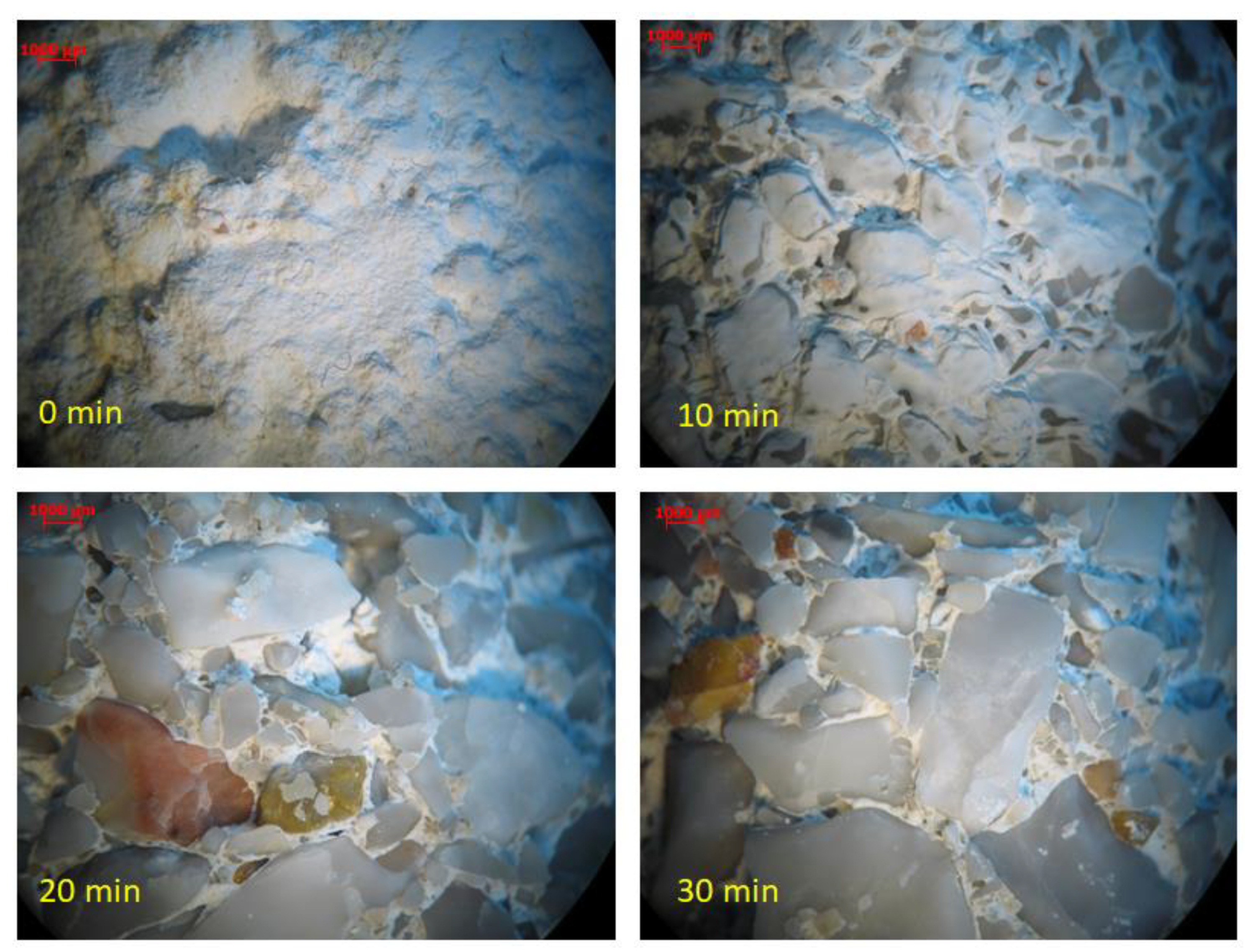
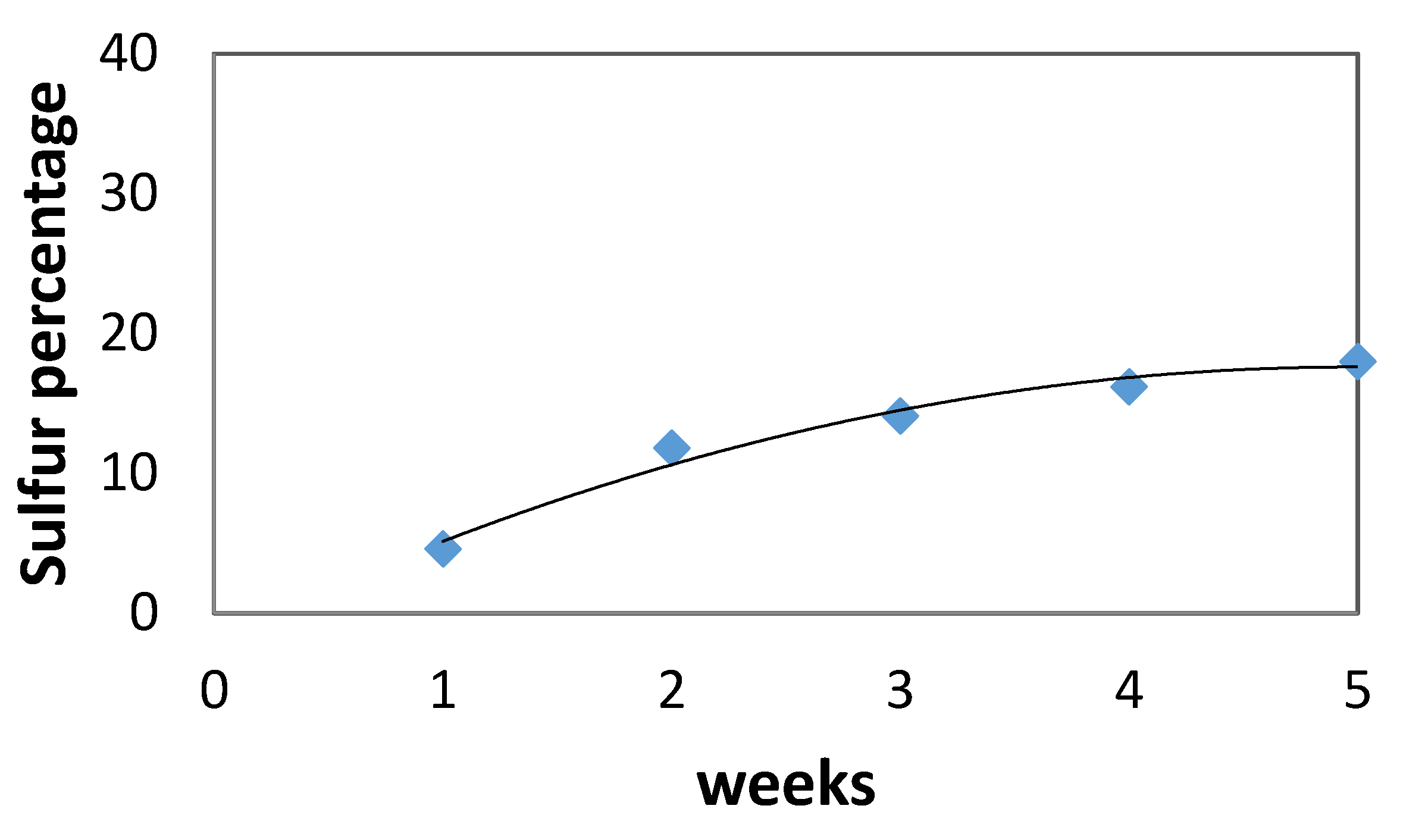
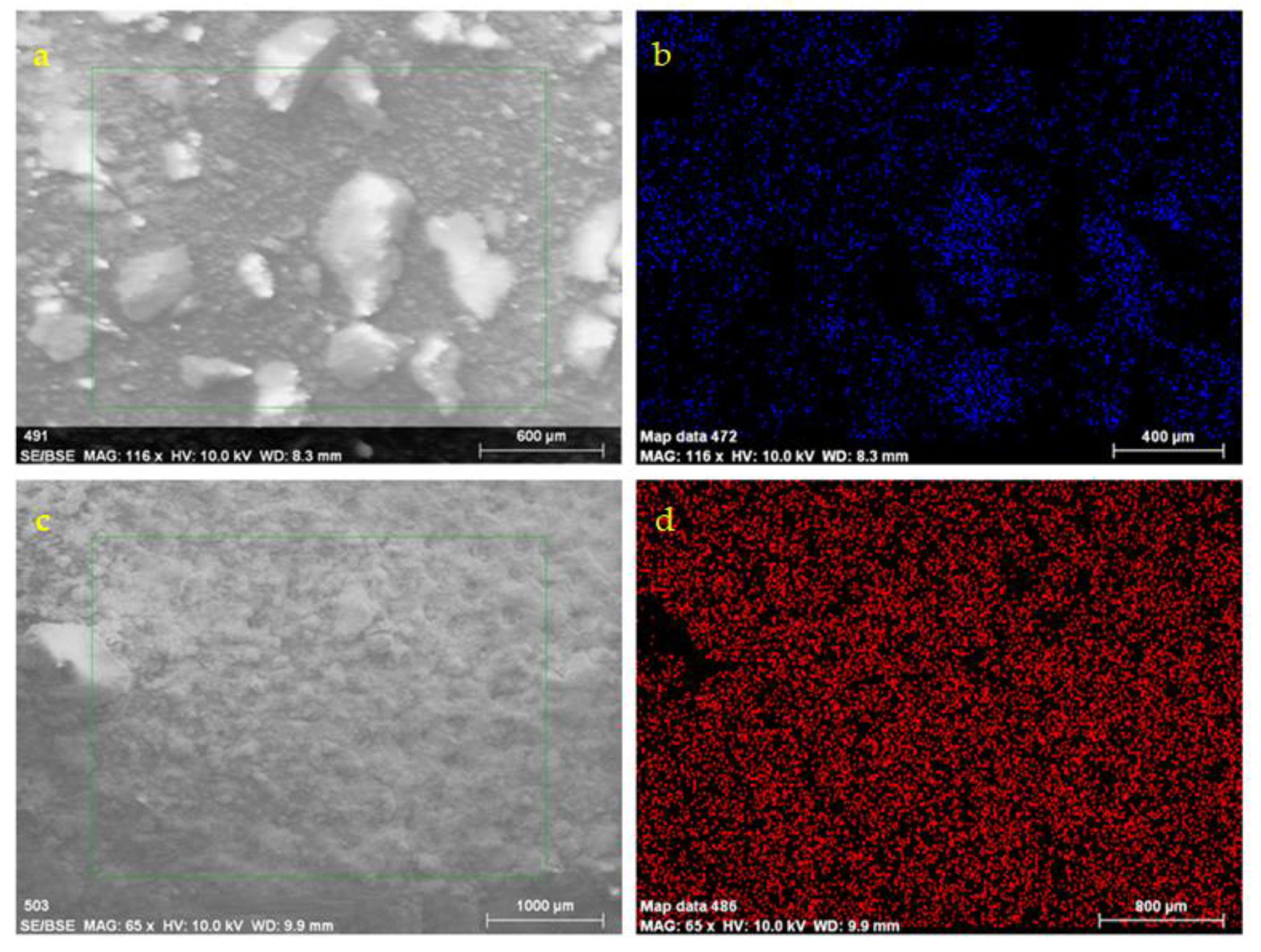
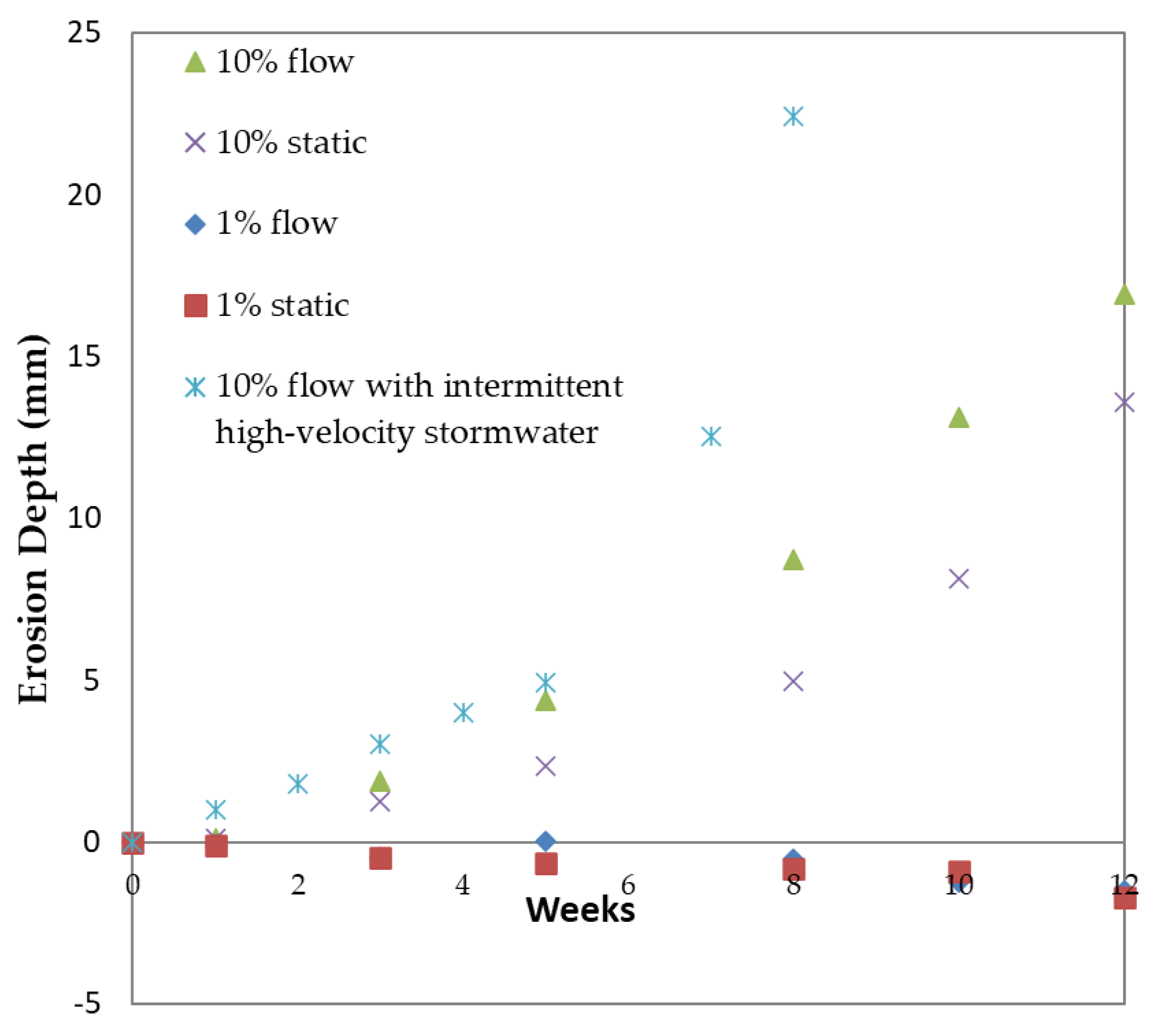
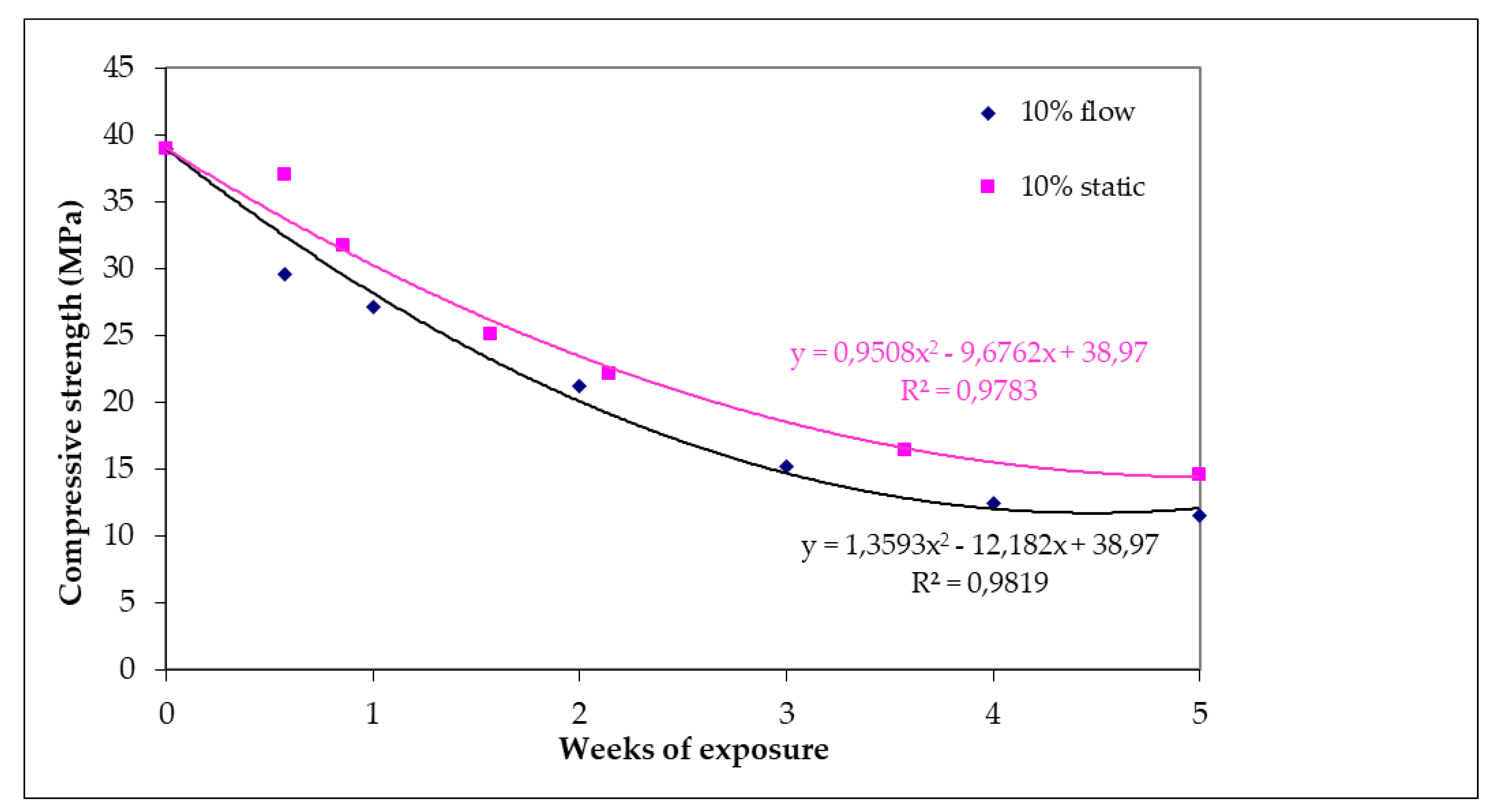
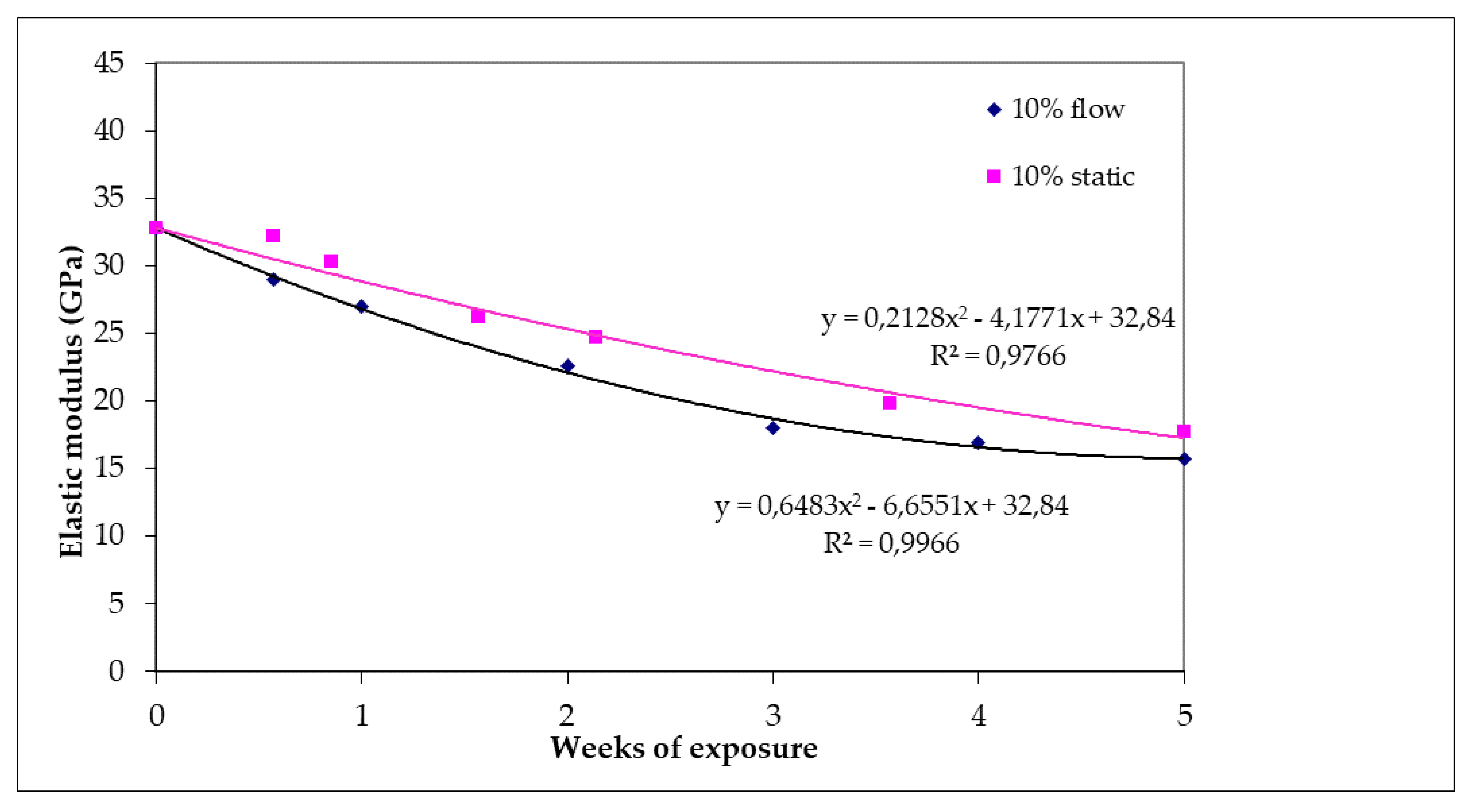
| Topic | Means of Investigation | Sections |
|---|---|---|
| Concrete preparation | Mix composition presented in Table 2. | Section 2.1 |
| Gypsum formation | Immersion into 1 wt% H2SO4 solution | Section 2.2, Section 3.1. |
| Gypsum removal | Application of water at a velocity of 7 m/s | Section 2.2, Section 3.1. |
| Sulfur content on surface | Quantification with SEM-EDS | Section 2.3, Section 3.2. |
| Effect of flow on corrosion | Constant acidic flows with a velocity of 0.06 m/s and stormwater flows at a velocity of 7 m/s | Section 2.4, Section 3.3. |
| Concrete mechanics | Unconfined compressive strength and elastic modulus | Section 2.5, Section 3.4. |
| Material | Type | Composition |
|---|---|---|
| Cement | CEM I 42.5 R | 410 kg/m3 |
| Water | Tap water | 184.5 kg/m3 |
| Limestone sand | 0–4 mm | 895 kg/m3 |
| Limestone grit | 4–8 mm | 895 kg/m3 |
| Plasticizer | SP Viscocrete | 0.5 wt.% of cement |
Publisher’s Note: MDPI stays neutral with regard to jurisdictional claims in published maps and institutional affiliations. |
© 2021 by the authors. Licensee MDPI, Basel, Switzerland. This article is an open access article distributed under the terms and conditions of the Creative Commons Attribution (CC BY) license (http://creativecommons.org/licenses/by/4.0/).
Share and Cite
Fytianos, G.; Tsikrikis, A.; Anagnostopoulos, C.A.; Papastergiadis, E.; Samaras, P. The Inclusion of Acidic and Stormwater Flows in Concrete Sewer Corrosion Mitigation Studies. Water 2021, 13, 261. https://doi.org/10.3390/w13030261
Fytianos G, Tsikrikis A, Anagnostopoulos CA, Papastergiadis E, Samaras P. The Inclusion of Acidic and Stormwater Flows in Concrete Sewer Corrosion Mitigation Studies. Water. 2021; 13(3):261. https://doi.org/10.3390/w13030261
Chicago/Turabian StyleFytianos, Georgios, Anastasios Tsikrikis, Costas A. Anagnostopoulos, Efthimios Papastergiadis, and Petros Samaras. 2021. "The Inclusion of Acidic and Stormwater Flows in Concrete Sewer Corrosion Mitigation Studies" Water 13, no. 3: 261. https://doi.org/10.3390/w13030261
APA StyleFytianos, G., Tsikrikis, A., Anagnostopoulos, C. A., Papastergiadis, E., & Samaras, P. (2021). The Inclusion of Acidic and Stormwater Flows in Concrete Sewer Corrosion Mitigation Studies. Water, 13(3), 261. https://doi.org/10.3390/w13030261






